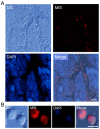Immunohistochemical Characterization of Spermatogenesis in the Ascidian Ciona robusta
- PMID: 39594612
- PMCID: PMC11592721
- DOI: 10.3390/cells13221863
Immunohistochemical Characterization of Spermatogenesis in the Ascidian Ciona robusta
Abstract
Animals show diverse processes of gametogenesis in the evolutionary pathway. Here, we characterized the spermatogenic cells in the testis of the marine invertebrate Ciona robusta. Ciona sperm differentiate in a non-cystic type of testis, comprising many follicles with various sizes and stages of spermatogenic cells. In the space among follicles, we observed free cells that were recognized by antibody against Müllerian inhibiting substance, a marker for vertebrate Sertoli cells. We further categorized the spermatogenic cells into four round stages (RI to RIV) and three elongated stages (EI to EIII) by morphological and immunohistochemical criteria. An antibody against a vertebrate Vasa homolog recognized a few large spermatogonium-like cells (RI) near the basal wall of a follicle. Consistent with the period of meiosis, a synaptonemal complex protein SYCP3 was recognized from early spermatocytes (RII) to early spermatids (E1). Acetylated tubulins were detected in spermatids before flagellar elongation at the RIV stage and became distributed along the flagella. Electron microscopy showed that the free cells outside the testicular follicle possessed a characteristic of vertebrate Sertoli cells. These results would provide a basis for basic and comparative studies on the mechanism of spermatogenesis.
Keywords: Sertoli cell; ascidian sperm; cilia and flagella; spermatogenesis.
Conflict of interest statement
The authors declare no conflicts of interest.
Figures








Similar articles
-
[Identification of human testicular spermatogenic cells at different stages].Beijing Da Xue Xue Bao Yi Xue Ban. 2006 Aug 18;38(4):441-3. Beijing Da Xue Xue Bao Yi Xue Ban. 2006. PMID: 16892157 Chinese.
-
Cytological features of spermatogenesis in Opsariichthys bidens (Teleostei, Cyprinidae).Anim Reprod Sci. 2020 Nov;222:106608. doi: 10.1016/j.anireprosci.2020.106608. Epub 2020 Sep 22. Anim Reprod Sci. 2020. PMID: 33039822
-
Immunohistochemical analysis of cAMP response element-binding protein in mouse testis during postnatal development and spermatogenesis.Histochem Cell Biol. 2009 Apr;131(4):501-7. doi: 10.1007/s00418-009-0554-8. Epub 2009 Jan 16. Histochem Cell Biol. 2009. PMID: 19148668
-
Morphological appraisal of gametogenesis. Spermatogenetic process in mammals with particular reference to man.Andrologia. 1975;7(2):141-63. doi: 10.1111/j.1439-0272.1975.tb01247.x. Andrologia. 1975. PMID: 1103652 Review.
-
Mechanisms Regulating Spermatogonial Differentiation.Results Probl Cell Differ. 2016;58:253-87. doi: 10.1007/978-3-319-31973-5_10. Results Probl Cell Differ. 2016. PMID: 27300182 Review.
References
-
- Russell L.D., Ettlin R.A., Hikim A.P., Clegg E.D. Mammalian spermatogenesis. In: Russell L.D., Ettlin R., Sinha Hikim A.P., Clegg E.D., editors. Histological and Histopathological Evaluation of the Testis. Cache River; Clearwater, FL, USA: 1990. pp. 1–40.
-
- Satoh N. Developmental Genomics of Ascidians. Wiley-Blackwell; Hoboken, NJ, USA: 2014. pp. 1–216.
Publication types
MeSH terms
LinkOut - more resources
Full Text Sources
Research Materials

